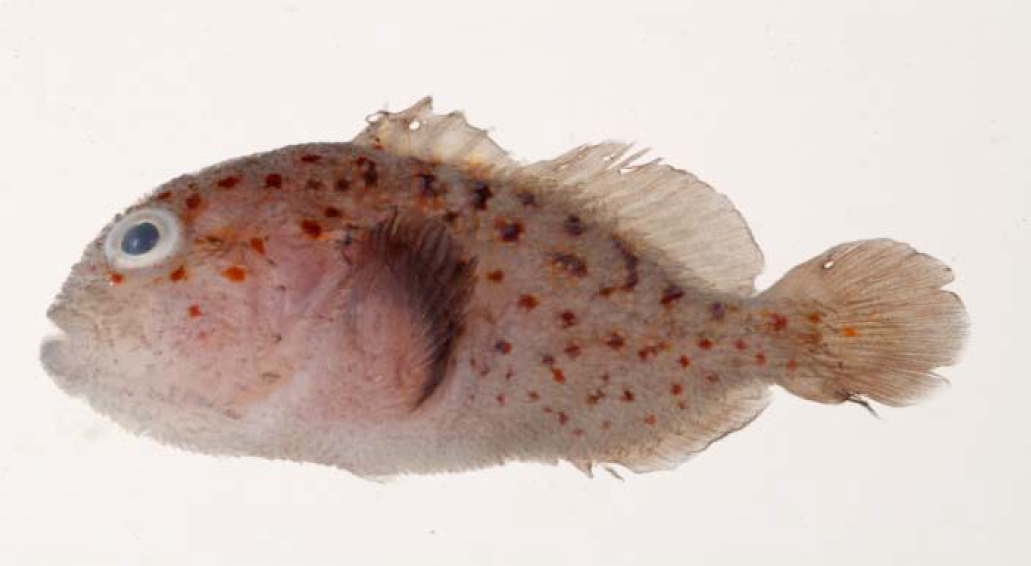Moorea: The Coral Reef Community
Caracanthus maculatus Fish
Caracanthus unipinna Fish
Moorea
From the researcher's perspective...
Caracanthis unipinna, the Pygmy Coral Croucher, is easily overlooked within the branches of coral, and that is part of its plan. Looking like a harmless blob, this fish wedges itself between coral branches in the depths of the corals, preying on other coral-dwellers who come for shelter. It's covered with papillae, giving it a fuzzy appearance and a sponge disguise, but with venomous dorsal fin spines nothing about this fish is warm or soft. They can however, be nice to each other—males and females form monogamous pairs, and small groups of Crouchers develop what may be complex social interactions within the depths of host corals. They are true to their corals, and once settled into one, spend the rest of their lives in that same coral head.
Caracanthis maculates, the Spotted Coral Croucher, is the good-looking, friendly cousin of the Pygmy Coral Croucher. It is light grey/tan in color with reddish spots, and its body is covered with papillae, giving it a furry appearance similar to C. unipinna. Like the other Coral Crouchers, it lives down in the depths of its host corals, eating unsuspecting invertebrates that venture into the coral branches. Because species of Caracanthis are hard to see, we know little about the ecology of these fishes, and the role they play on the reef—we think that they play an important role in regulating densities of coral-associated organisms. Despite all that is unknown about Caranthis, one thing is certain: when we peer into a coral head, whether we see them or not, Crouchers are in there looking back out at us!
Chris Meyer, Seabird McKeon, Hannah Stewart, and Matthew Johnson
DNA Barcode of Caracanthus maculatus
Accessed from Barcode of Life Data Systems
MBFA040-07 | MNHN_2008-197 | Caracanthus maculatus | COI-5P
ACCCTTTACCTCGTATTTGGTGCCTGAGCCGGAATGGTCGGCACAGCCCTGAGTCTGCTTATTCGAGCAGAGCTT AGCCAACCCGGGGCTCTTCTAGGGGACGACCAGATCTACAACGTTATTGTTACAGCACATGCCTTTGTAATAATC TTCTTTATAGTAATACCAATTATAATTGGCGGGTTTGGAAACTGGCTTATCCCACTAATGATTGGGGCTCCCGAT ATAGCGTTCCCTCGTATAAACAATATGAGCTTCTGGCTCCTGCCTCCTTCTTTCCTCCTACTACTGGCTTCGTCA GGCGTCGAAGCAGGAGCTGGGACAGGATGAACGGTGTACCCCCCTCTGGCCGGGAACTTAGCGCACGCCGGAGCC TCTGTTGACCTGACAATTTTTTCCCTTCACCTGGCGGGGGTCTCATCGATTTTAGGGGCAATTAATTTTATTACC ACAATTATTAACATAAAACCCCCAGCAATCTCCCAGTACCAAACACCCTTATTCGTGTGGGCCGTACTAATTACG GCTGTGCTCCTACTGCTGTCCCTCCCAGTACTTGCCGCCGGAATCACCATGCTTCTGACGGACCGAAACTTAAAC ACCACTTTCTTTGACC

DNA Barcode of Caracanthus unipinna
Accessed from Barcode of Life Data Systems
MBFA811-07 | MNHN_2008-986 | Caracanthus unipinna | COI-5P
ACCCTTTACCTGGTATTTGGTGCCTGAGCCGGAATGGTCGGCACTGCCCTAAGCCTACTTATCCGAGCAGAGCTC AGCCAACCCGGGGCCCTTCTAGGGGACGACCAGATCTACAATGTTATTGTTACAGCACATGCCTTCGTAATAATC TTTTTTATAGTGATACCTATTATGATTGGAGGGTTTGGAAACTGGCTTATTCCACTAATAATTGGGGCCCCTGAC ATAGCATTCCCCCGTATAAACAACATAAGCTTCTGACTTTTACCCCCTTCTTTCCTCTTGCTACTAGCCTCATCA GGCGTCGAAGCAGGGGCCGGGACAGGATGGACAGTATACCCGCCTCTGGCCGGGAACCTAGCACACGCCGGGGCT TCAGTTGACCTGACAATTTTTTCACTCCACCTAGCAGGGGTCTCATCAATTCTAGGGGCTATTAACTTTATTACC ACCATTATTAATATAAAACCTCCAGCAATTTCCCAATATCAGACACCTCTGTTCGTTTGAGCCGTACTAATTACG GCTGTGCTTCTATTACTATCCCTTCCAGTGCTTGCCGCCGGTATCACAATACTACTAACGGACCGAAACTTAAAC ACCACCTTTTTTGACCCAGCAGGAGGAGGGGACCCTATTCTTTACCAACACCTA



